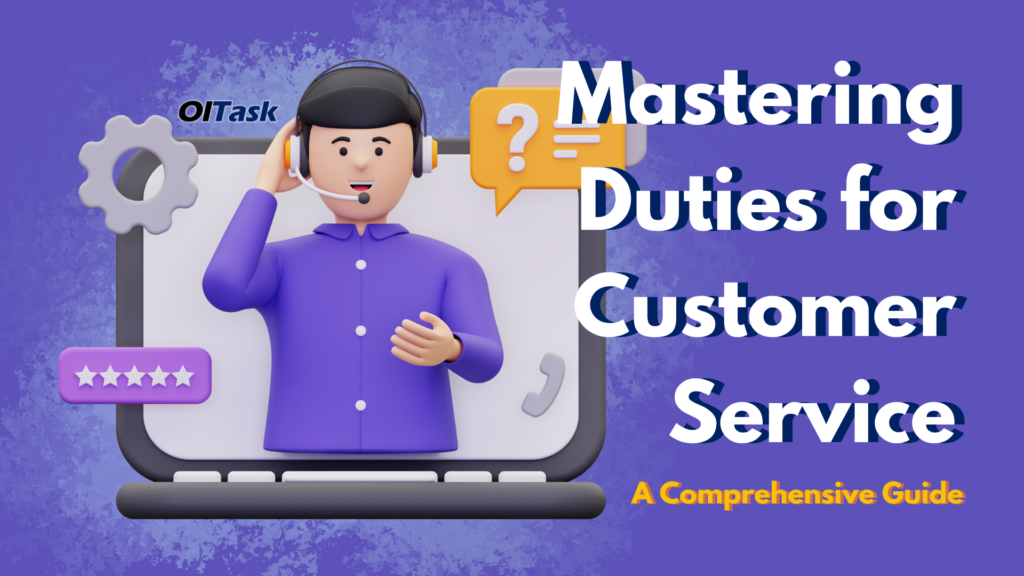Mastering Duties for Customer Service: A Comprehensive Guide

In the marketing world, the customer is always the number one priority. Therefore, understanding the duties for customer service is pivotal for any organization aiming to provide exceptional support and top-tier service. This comprehensive guide delves into the various aspects of customer service roles and strategies to enhance overall customer satisfaction.
The Role of Customer Service Representatives

Customer service representatives play a crucial role in the success of any business, acting as the primary point of contact between a company and its customers. Their responsibilities extend beyond mere transactional interactions; they embody the voice and values of the company, significantly impacting customer perception and satisfaction.
Key Responsibilities and Duties
- Handling Customer Inquiries: One of the primary duties of customer service representatives is to respond to customer inquiries. This includes providing information about products and services, assisting with orders, and addressing any queries customers might have.
- Problem Solving and Issue Resolution: Representatives are often tasked with resolving customer issues. This can range from simple problems like account updates to more complex issues such as resolving product defects or service failures.
- Providing Product Support: In-depth knowledge of the company’s products or services is essential. Representatives must be able to offer accurate and helpful advice, guiding customers through product features, usage, and troubleshooting.
- Processing Orders and Transactions: This includes managing customer orders, processing payments, issuing refunds, or handling billing inquiries. For some companies, this might also involve managing credit or reward programs.
- Recording Customer Interactions: Documenting interactions in CRM systems or customer databases is a crucial duty of customer service. This helps in maintaining a record of customer interactions and issues, which is valuable for future reference and for improving service.
- Feedback Collection and Escalation: Collecting customer feedback and escalating serious issues or complaints to higher authorities when necessary is also part of their role.
Enhancing Communication Skills
In the domain of customer service, the ability to communicate effectively is key. As a customer service representative, enhancing communication skills is not just about conveying information, but also about building trust and rapport with customers.
Key Elements of Effective Communication
- Clarity and Conciseness: Communicating in a clear, concise manner helps prevent misunderstandings. Customer service representatives need to be straightforward while also being thorough in their explanations.
- Empathy and Understanding: Showing empathy involves understanding and reflecting on the customer’s feelings and perspectives. It’s a vital skill that helps in building a connection with the customer.
- Active Listening: This involves not just hearing the customer’s words, but also understanding the underlying messages or emotions. Active listening can lead to more accurate responses and better problem resolution.
- Positive Language and Tone: The use of positive language and an appropriate tone can significantly impact customer interactions. It’s about framing responses in a way that is focused on solutions and constructive outcomes.
- Adaptability in Communication: Customers vary in their communication styles and preferences. Being adaptable means altering one’s communication approach to meet the customer’s style, whether it’s formal, informal, detailed, or concise.
- Handling Difficult Conversations: Dealing with upset or frustrated customers is a challenge. Representatives need to maintain professionalism and use de-escalation techniques to manage these situations effectively.
Incorporating these communication skills effectively can transform the quality of customer interactions, similar to the high standards of service detailed in our discussion on What is White Glove Service.
Importance of Customer Feedback

Customer feedback is the cornerstone of improving customer service. It provides direct insights into customer experiences, expectations, and areas needing improvement.
Utilizing Feedback for Service Enhancement
- Identifying Areas for Improvement: Feedback helps identify specific aspects of customer service that need enhancement. This could be in communication, response times, product knowledge, or issue resolution.
- Measuring Customer Satisfaction: Regularly collecting feedback is a way to measure customer satisfaction. This can be done through surveys, feedback forms, or direct conversations.
- Informing Training and Development: Feedback can guide the training and development of customer service teams. It helps in tailoring training programs to address the actual issues faced by representatives.
- Enhancing Products and Services: Feedback isn’t just about the service; it’s also about the products or services offered. It can provide valuable insights for the product development team to make necessary adjustments.
- Building Customer Relationships: Responding to feedback, especially when it involves resolving a customer’s issue, can strengthen the relationship between the business and the customer.
- Creating Ideal Customer Profiles: Understanding customer feedback helps in creating ideal customer profiles, which are essential for tailoring service and marketing efforts. These profiles, as detailed in our article on Ideal Customer Profiles, are pivotal for targeted and effective customer service strategies.
Job Description Templates and Interview Questions

Creating effective job description templates and preparing relevant interview questions are key steps in hiring competent customer service representatives. These tools help in identifying and selecting candidates who are not only skilled but also a good fit for the company’s culture and customer service philosophy.
Curating a Comprehensive Job Description
- Outline of Duties: The job description should list the duties for customer service, including handling customer inquiries, managing complaints, and maintaining customer satisfaction.
- Skill Requirements: Enumerate the necessary skills such as excellent communication skills, problem-solving abilities, and proficiency in relevant software or CRM systems.
- Qualifications and Experience: Be specific about your required educational qualifications, number of years of relevant experience, and any specific training or certifications you seek for the job.
- Personality Traits: Highlight traits like patience, empathy, and adaptability, which are crucial for customer support roles.
Developing Interview Questions
- Scenario-Based Questions: These questions help assess how candidates would handle specific customer service situations, reflecting their problem-solving and decision-making skills.
- Behavioral Questions: Asking about past experiences in customer service can provide insights into the candidate’s skills and approach to customer support.
- Questions on Customer Service Philosophy: Understanding the candidate’s views on customer service helps gauge whether they align with the company’s values and approach.
Training and Development
Training and development are crucial elements in the duties for customer service, ensuring that customer service representatives are equipped with the necessary skills and knowledge to perform their roles effectively.
Importance of Ongoing Training
- Product Knowledge: Constant training is essential for representatives to stay updated on the company’s products or services. This ensures that they will provide accurate information to customers.
- Skill Enhancement: Training programs should focus on enhancing various skills, including communication skills, problem-solving, and customer support techniques. This improves service quality and boosts the confidence of the representatives.
- Adapting to Customer Needs: As customer expectations evolve, training helps representatives learn how to approach these changing needs, ensuring continued customer satisfaction.
- Role-Specific Training: Depending on their role, service representatives might need specialized training. For instance, a support specialist may require in-depth technical training, whereas a general customer service agent might focus more on communication and problem-solving skills.
- Soft Skills Development: Training in soft skills like empathy, patience, and active listening is vital for handling customer interactions effectively, especially when dealing with complaints or difficult customers.
- Regulatory Compliance: Keeping the team updated on legal and regulatory changes related to customer service is crucial, particularly in industries like finance or healthcare.
Technology in Customer Service
Technology plays a pivotal role in modern customer service, streamlining operations and enhancing the overall customer experience. In this day and age, integrating technology into almost every process is necessary for ease and convenience.
Integrating Technology for Efficient Service
- Customer Relationship Management (CRM) Systems: CRM systems help in managing customer interactions, tracking service issues, and storing customer information, enabling a more personalized and efficient service.
- Automated Responses and Chatbots: Automation, through AI-powered chatbots, can handle basic customer queries efficiently, freeing up human representatives to tackle more complex issues.
- Social Media Tools: Utilizing social media tools for customer service allows businesses to engage with customers where they are most active. These tools can help in monitoring social media mentions and managing responses.
- Data Analytics: Analytics tools can evaluate large volumes of customer feedback and interaction data, providing insights into customer behavior and service performance.
- Self-Service Options: Providing customers with self-service options, like FAQs and knowledge bases, empowers them to find answers to their questions quickly and conveniently.
- Remote Support Technology: With the rise of remote work, technology enables customer service teams to operate effectively from various locations, ensuring uninterrupted service delivery.
Incorporating these aspects of training and development and leveraging technology can significantly enhance the capabilities of a customer service team. It not only improves the efficiency of the service provided but also enhances the overall customer experience, solidifying the company’s reputation as a customer-centric organization.
Handling Difficult Situations

Handling difficult situations is an inevitable part of the duties for customer service. These scenarios can range from dealing with unhappy customers to resolving complex issues. As a customer service representative, it is vital to manage these situations effectively to maintain customer satisfaction and uphold the company’s reputation.
Strategies for Managing Difficult Customer Interactions
- Stay Calm and Professional: Regardless of the customer’s tone or behavior, the service representative must remain calm and professional. This sets the tone for the interaction and can help de-escalate the situation.
- Listen Actively: Allow the customer to express their concerns without interruption. Active listening demonstrates empathy and can often diffuse tension.
- Acknowledge and Apologize: Acknowledge the customer’s issue and apologize if necessary. This does not necessarily mean admitting fault but showing understanding and concern for the customer’s situation.
- Find a Solution: Focus on finding a practical solution to the customer’s problem. This might involve offering a replacement, refund, or another form of resolution.
- Follow-Up: After resolving the issue, following up with the customer can turn a negative experience into a positive one. It shows that the company values its customers and is committed to their satisfaction.
- Learn and Improve: Every difficult situation is an opportunity to learn. Analyzing these interactions can provide insights into how similar issues can be prevented or better handled in the future.
Handling these challenging interactions is not just about immediate problem-solving but also about understanding the broader market and customer base, as discussed in our analysis of the Service Addressable Market.
Measuring Customer Satisfaction

Measuring customer satisfaction is essential to understand how well the customer service team is performing and where improvements can be made. It’s a key indicator of customer loyalty and business health.
Techniques for Measuring Satisfaction
- Surveys and Feedback Forms: Using surveys or feedback forms immediately after service interactions provide direct insights into the customer’s experience.
- Net Promoter Score (NPS): NPS measures the likelihood of customers recommending the company to others. It is a powerful indicator of customer loyalty and overall satisfaction.
- Customer Satisfaction Score (CSAT): CSAT measures how satisfied customers are with a company’s products or services. It’s usually obtained through a direct question like “How satisfied were you with your experience?”
- Social Media Monitoring: Monitoring mentions and customer feedback on social media platforms can provide unfiltered opinions about the company’s service.
- Service Quality Metrics: Metrics like response time, resolution time, and issue escalation rates are useful for evaluating the efficiency and effectiveness of the customer support team.
- Analyzing Repeat Business and Customer Retention: Repeat business and customer retention rates can indirectly reflect customer satisfaction. High retention can indicate satisfied customers.
In conclusion, effectively handling difficult situations and accurately measuring customer satisfaction are vital aspects of duties for customer service. These practices not only help in resolving immediate customer issues but also contribute to long-term business success by ensuring that services are aligned with customer needs and expectations.
Teamwork and Collaboration
Effective teamwork and collaboration are essential in ensuring a seamless customer service experience. The service team must work cohesively, supporting each other and sharing knowledge and insights.
Fostering a Collaborative Environment
- Cross-Departmental Collaboration: Customer service often intersects with other departments like sales, marketing, and technical support. Ensuring open communication and collaboration across departments is crucial for comprehensive customer support.
- Regular Team Meetings: These meetings can be used to share updates, discuss challenges, and brainstorm solutions, fostering a sense of unity and purpose within the service team.
- Shared Goals and Metrics: Aligning the team with common goals and performance metrics helps ensure everyone is working towards the same objectives, enhancing overall customer satisfaction.
The Future of Customer Service
The future of customer service is shaped by technological advancements, evolving customer expectations, and new service channels. Staying ahead in this dynamic landscape is vital for businesses to maintain and grow their customer base.
Emerging Trends in Customer Service
- Artificial Intelligence and Automation: AI and automation are transforming how customer interactions are managed, offering efficient and personalized customer support.
- Omnichannel Service: Providing a seamless customer experience across various channels, including social media, chat, email, and phone, is becoming increasingly important.
- Remote Customer Service: With the rise of remote work, there’s a growing need for technology and strategies that support remote customer service teams.
- Personalization: Leveraging data analytics for personalized service is becoming a key differentiator in customer service.
- Proactive Customer Service: Anticipating customer needs and addressing them proactively is an emerging trend that can enhance customer satisfaction and loyalty.
Crafting detailed job description templates, preparing effective interview questions, fostering teamwork and collaboration, and staying abreast of future trends are all critical to maintaining a high standard of customer service. These elements work together to ensure that the customer service team is well-equipped, cohesive, and prepared to meet the challenges of today’s and tomorrow’s customer service landscape.
Duties for Customer Service: A Continuous Journey
Mastering the duties for customer service is a continuous journey that involves learning, adapting, and innovating. If you’re looking to enhance your customer service capabilities or require expert assistance, consider our specialized services at Oltask. Our tailored solutions in customer support, outbound sales, and SEO services cater to the unique needs of e-commerce businesses, SaaS companies, and SMEs. Start your journey towards exceptional customer service today with our free trial. Elevate your customer service standards and watch your business grow.